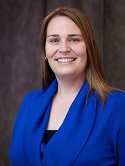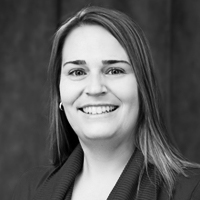The Benefits of Offering Neuromonics Tinnitus Treatment for Audiologists
Carolyn Smaka: Welcome. It’s great to talk with you today. Let’s start with a Neuromonics portfolio overview.

Sarah Smith: Thank you. Neuromonics has new, exciting and effective options for patients with tinnitus.
We know that every tinnitus patient that comes in the door is unique. In order to enable professionals to provide individualized treatment, we recently expanded our product line.
In January 2014 we introduced the Haven™, a mid-level device that we consider a tinnitus management tool. It’s great for patients whose tinnitus is not severe. These are patients that may not necessarily hear the tinnitus every day, but when they do hear it they are extremely bothered by it. While they are using Haven, they experience relief and relaxation. We have seen great results with the Haven device. With these patients, if you can make their tinnitus better, they will be successful and happy in the long term.
The Neuromonics Sanctuary™ was introduced in 2013. The Sanctuary is an entry-level device specifically made for the VA and Department of Defense hospitals, which has also been incredibly successful in private practices. Often times, a tinnitus patient may come up on our schedule but our calendars are booked. It is difficult to schedule them to come back in for a follow up appointment, and it is beneficial to send them out with a device on the first appointment. The Sanctuary was specifically designed for immediate same day fitting, and the fitting protocols are very easy. The device can be programmed and fit in less than one minute, using an onboard clinician menu. There is no software needed. As I mentioned, the candidates for this device do not have severe tinnitus; Sanctuary addresses the emotional components such as fear, anxiety and the feeling of a lack of control over the tinnitus.
Our flagship Oasis™ was redesigned in January of 2014 with the goals of being able to create same day fittings, and compatibility with NOAH software. Through Neuromonics’ NeuroFit software, clinicians can address changing thresholds if the patient’s hearing loss changes. Clinicians also have access to new tracks to best meet each patient’s needs. In the software, professionals can also change the amount of neurostimulation to provide more stimulation for maximum relief and coverage if needed. Our second-generation Oasis has been well received by clinics that work with patients who have a more significant tinnitus response. We have shown that patients who complete and are compliant with their treatment plan end up having significant long-term reduction in their awareness of and disturbance from tinnitus. It’s a very well-rounded and robust product line that offers clinicians to the ability to provide individualized treatment to a wide range of tinnitus patients they see in their practices.
Carolyn: In terms of candidacy, when would a clinician look to the Neuromonics portfolio for a patient with tinnitus, and when would they look to a noise program that is available in many hearing aids today?
Sarah: That is a great question and one that I often get asked by clinicians. First, as a tinnitus provider, you need to offer multiple options. Specifically, the Neuromonics’ devices are tinnitus-specific products that are not hearing aids. Nor are they ear-level worn devices that look like hearing aids. Some patients looking for tinnitus solutions may have rejected amplification, and some may not be candidates for amplification. With a Neuromonics device, you do not have to tell them they are getting a hearing aid.
Neuromonics recently redesigned our devices. The redesign of the Sanctuary case, which eventually became the case for all of our new devices, was funded by a grant from the Department of Defense. The grant was issued because of the positive results in treating tinnitus with Neuromonics devices in patients who were active duty military. On the other hand, there were also a large number of patients that were noncompliant with tinnitus treatment. When they investigated, they found that the noncompliant patients did not want to use a product that looked like a medical device. They did not want to use a product that could imply they had a medical issue or were not fit for duty.
We see the same beliefs and thought processes in many tinnitus patients walking in to audiology offices. The first thing they think of is that the clinician will tell them that they need a hearing aid. Neuromonics devices look more like modern MP3 players than hearing aids. The designs of the devices are intentional in that they address the fear and the stigma issues that unfortunately some patients have about hearing aids. They enable you to deliver a highly effective, proven treatment that is well received among the tinnitus community.
In addition, some patients with bothersome tinnitus may already have hearing aids. They may be appropriately fit with good hearing aids yet still complain about tinnitus, either while the hearing aids are on or when they take them off. We have devices that can be used as an accessory for patients when they are not wearing hearing aids. They are not meant to take the place of the hearing aids, but as an accessory to address the tinnitus. Our well-balanced product line gives clinicians the opportunity to offer the care they need for each individual patient.
Carolyn: What I’m hearing is that even though hearing loss and tinnitus often co-exist, the motivation to seek treatment for one or the other may be very different for patients.
Sarah: Exactly. When a patient walks in to your office and their primary concern is tinnitus, you can counsel them all you want to address their hearing loss but you probably won’t move them into hearing aids. They truly have the belief that tinnitus is the cause of their hearing difficulties. For a lot of patients, the hearing aid discussion will drive them out of your office. Yet, if you address tinnitus as the primary concern, they become life-long, loyal patients. And, you differentiate yourself because not every practice offers tinnitus services.
A lot of patients with tinnitus have seen numerous audiologists, and have been told time and again to address the hearing loss. They have also heard, “nothing can be done, you need to live with your tinnitus”. If you address the tinnitus, teach them that they do have choices, and provide them with an effective treatment, they are your patients for life. A patient who has been successful with tinnitus treatment through your practice and needs hearing aids, will eventually purchase hearing aids from you.
Carolyn: Some audiologists may not feel confidant offering tinnitus services, as they may not have had much training or education in this area.
Sarah: As a manufacturer, we have asked ourselves how we can help clinicians gain that self-confidence. When we released our first product, we required multiple days of training in order to become a provider. We have since learned that it does not have to be that complicated, and have simplified our training. Many audiologists today have knowledge of what tinnitus is, understand the neurophysiologic model of tinnitus, and why patients with tinnitus present with emotional and psychological needs. From a training standpoint, we find 2-3 hours of training is typically all that is needed before offices are ready to see their first tinnitus patient. Training can certainly be ongoing and we support new clinicians until they are ready.
Carolyn: I’ve heard some tinnitus patients can have a lot of emotional needs and it can be intimidating for some clinicians.
Sarah: In terms of how to manage those high-intensity patients, I suggest thinking about putting yourself in the patient’s shoes. They are experiencing a sensory input over and over, they have no control over it, and there is no end in sight. Think about having water drip onto your forehead constantly that you cannot control, and there is no foreseeable cessation. Or a blister on your foot that rubs whenever you walk, but you can’t simply take off your shoe to find relief. It helps you to understand why these patients may be more anxious, and why they have a lot of questions for you, the professional. They may require more support and hand-holding, but the sooner they experience the relief and relaxation that occurs with the use of Neuromonics devices, many of their questions go away.
Their questions are based on a need for information, and a fear that the treatment is not going to work. They are afraid to invest in something that may not help, like the pills, supplements and other things they see advertised as “cures” that do not work. When you take away their fear by providing relief with a proven, effective treatment, many of their questions go away.
Carolyn: How do professionals get started offering Neuromonics products and treatment?
Sarah: Professionals can contact customer service at 866-606-3876 or myself at sarah.smith@neuromonics.com and we’ll get them started with a training based on their needs. If they are brand new to tinnitus, we’ll ensure they get the background information and foundation, as well as information about using our products. We also cover how to present potential options including our treatment protocol to patients. Most of our training is now online, versus the previous two-day in-person training we had in the past. Professionals can take the training at their own pace, and they have the opportunity to interact with their trainer and the materials.
Carolyn: Thanks Sarah. We invite professionals to visit www.neuromonics.com for more information, and to check out the Neuromonics Expo Page on AudiologyOnline for a list of online courses and trainings.

